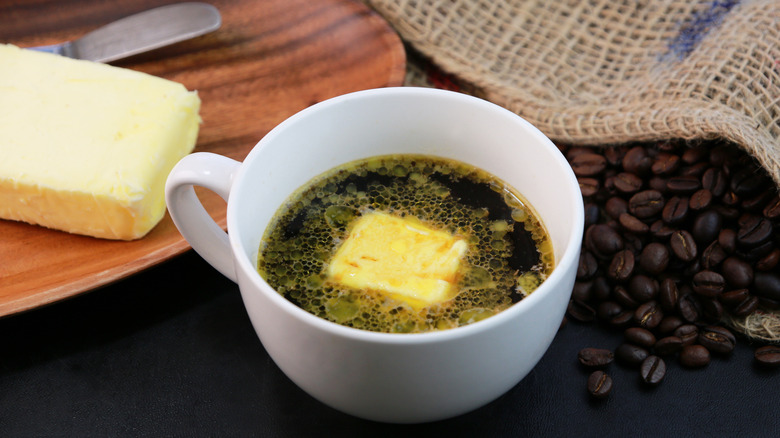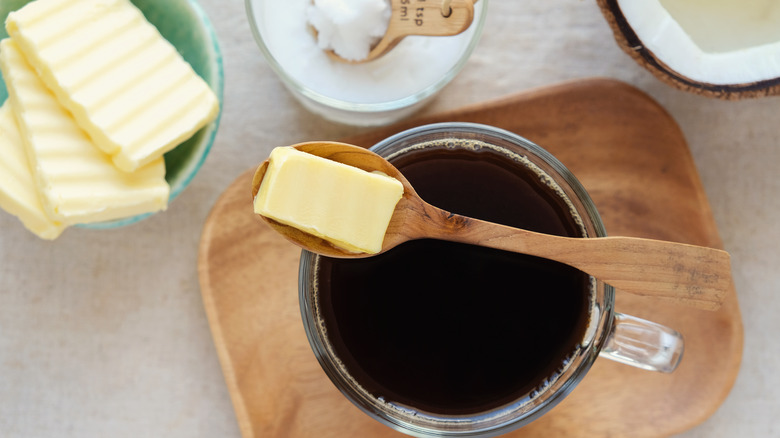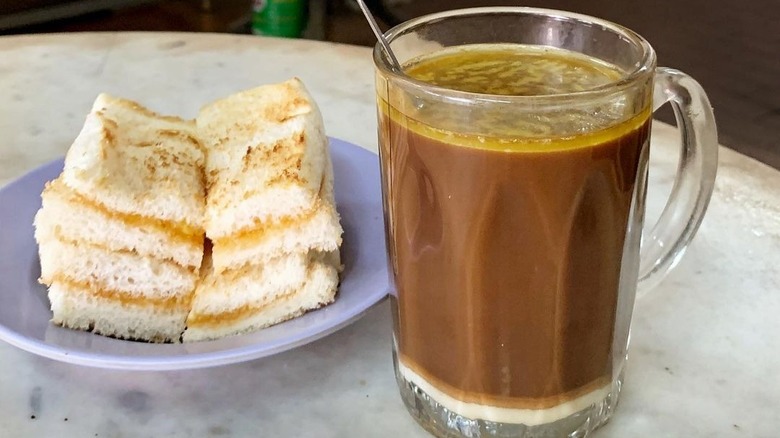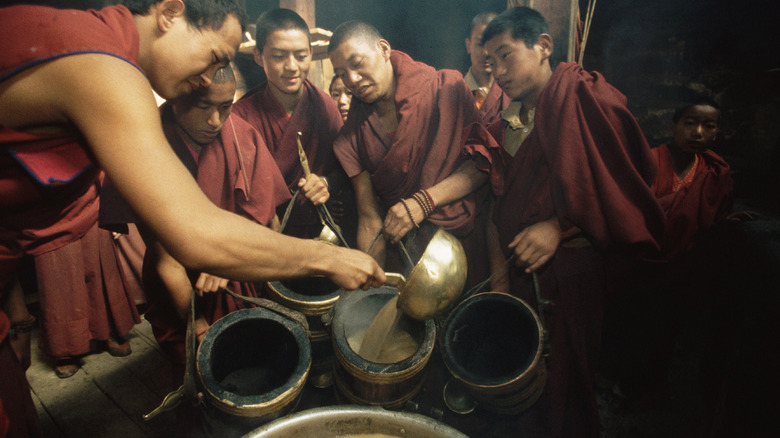What Is Butter Coffee And What Does It Taste Like?
If you've ever listened to a fitness podcast, tried the keto diet, or even lived with a fitness fiend, you'll know that a growing number of people are choosing to drink their coffee with butter, rather than milk or creamer. Since 2009, when bio-hacker Dave Asprey began to popularize the idea and called the coffee concoction "Bulletproof," butter coffee has gained millions of devotees. While Bulletproof is a brand name that uses Asprey's company's products — they curate their coffee beans and produce a specifically refined medium-chain triglyceride (MCT) oil for this purpose – butter coffee is any homemade version, typically made with unsalted butter and regular coconut oil, which is naturally a good source of MCTs.
Butter coffee tastes like a rich, creamy, slightly coconutty latte, with an aftertaste that's more buttery than milky, but it wasn't the taste that hooked Asprey. When trekking in subzero conditions around the holy Mt. Kailash in Tibet, Asprey learned firsthand how a buttery caffeine hit can reinvigorate your body and brain when he was given yak milk tea by a local woman. "I felt a mental clarity come on," Asprey told Insider. "Everything just felt easier." Though many people swear by the health benefits of butter coffee, the jury is still out in the medical establishment. However, if you're more interested in the prospect of adding buttery deliciousness to your morning caffeine hit for flavor rather than nutrition, there are versions available that taste more like a treat than a treatment.
Your butter coffee ingredients matter
Dave Asprey's original recipe for Bulletproof coffee specifies that you should add between 1 teaspoon to 2 tablespoons of MCT oil and up to 2 tablespoons of grass-fed unsalted butter or ghee (clarified butter) to a cup of black coffee. It's important to start small with your MCT oil and butter to let your stomach acclimate, then gradually build up. Also, use a blender to emulsify the fat and coffee into a foamy, creamy cup, otherwise, you'll end up with an unappetizing oil slick on your coffee and coating your mouth. But which butter is best and why does Asprey swear it needs to be grass-fed?
Well, according to Asprey, grass-fed butter is a superfood, and studies show it does indeed contain more nutrients than grain-fed butter, as well as short-chain fatty acids that are thought to help with inflammation. Asprey is also bullish about the health impacts of MCTs and certainly, research agrees they have proven benefits for people on a keto diet — the body breaks down some MCTs into ketones, which can help you stay in ketosis, the crucial weight-loss phase of the keto diet. Coconut oil is about 65% MCT, and many of the other benefits of MCT oil — energy, satiety, anti-inflammation, and heart health — are associated with coconut oil as well.
Southeast Asian coffee drinkers have known about butter coffee for a while
Butter coffee doesn't have to be all about the health benefits. People around the world have recognized butter's ability to add to the deliciousness of their hot drinks for centuries.
Vietnam is the world's second-largest coffee exporter and a few Vietnamese coffee varieties are actually roasted in butter for a smoother, richer, buttery flavor. In Malaysia, beans are roasted twice — a standard dry roast followed by a second round of roasting with sugar and butter to produce a dark, intense, caramelly coffee. These dark, Robusta-forward roasts that are typical of Southeast Asia aren't as aromatic as African or South American Arabica beans, but Robusta coffee shines best in the presence of dairy. Robusta's flavor is deeper and earthier, and its caffeine content is higher. A splash of milk — or more traditionally for the region, sweetened condensed milk — helps to open up the bitterness of the Robusta and highlight its nutty, chocolatey notes.
The richest, butteriest, Southeast Asian coffee preparation is Singapore's Kopi Gu You, a triple-layered drink with sweetened condensed milk, topped with strong, dark coffee, and finished with a slice of unsalted butter. While some believe it was originally favored by early Singapore construction workers for a cheap, quick, energizing breakfast, today it's a delicious pick-me-up that is enjoyed by people all over Singapore.
Buttering hot drinks has a long history
We are so used to adding milk to coffee nowadays that it's easy to believe that butter coffee is a new thing, but it's practically impossible to take butter out of coffee's history. The energy-giving properties of the coffee fruit were known far before the invention of the dark, bitter drink we know and love today. In Ethiopia, where coffee was first popularized in the 9th century, the beans would be ground up and mixed with butter, ghee, or other animal fats to make a paste that could be rolled up into balls and carried around. These were then chewed for a quick burst of energy, something that people still do in the mountainous regions around Keffa and Sidamo.
The other historical forerunner of butter coffee is yak butter tea. Dave Asprey's original inspiration sprung from the galvanizing impact that drinking this humble tea had on him during his travels to the region. Yak butter tea has been a staple for the people of the Himalayas and the Tibetan Plateau since the 10th century. Just like butter coffee, yak butter tea packs a caffeine hit into a creamy, warming beverage, replete with enough calories to keep you going no matter what mountain you have to climb.



